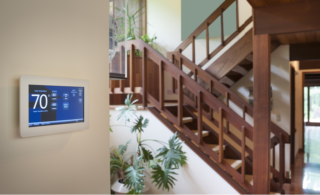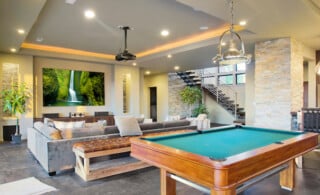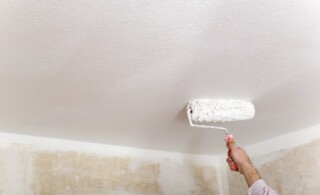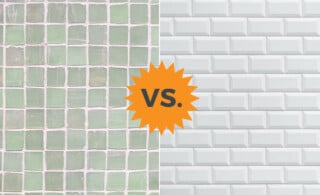
You know the color of paint you want, but you arrive at your local hardware store only to find that choosing the color is just the beginning of your painting project.
There you find a dizzying array of options, from matte paint to gloss paint to semi-gloss paint, from flat finish to satin finish. Then there’s exterior and interior paint. The options may seem endless. And then, to top it all off, you find primer and products that aren’t paint at all, like solvents and varnish. It’s easy to get lost.
Before you start, you’ll need to measure your surface so you can figure out how much paint you need and consider how much it costs to paint a room. And if you’re doing the painting yourself, you’ll need the proper painting equipment, such as the best paint brushes, drop cloths, painter’s tape, rollers, roller trays, brush cleaner and more. (If you plan to paint up high, make sure you have a ladder or step-ladder, too.)
But fear not. There’s a way to make sense of it all and find your way through the maze of this particular home improvement project to the other side: a completed paint job you’ll be proud of and that will look great in your home. If in doubt, consider hiring a local professional painter.
Check Your Interior Paint Type
Before you decide what type of paint is best for your project, check your existing interior paint type and condition. You can use acetone or methylated spirits to determine what kind of paint you have: water- or oil-based.
Methylated spirits and acetone are both solvents. Acetone is most well known as a nail polish remover. Methylated spirits, sometimes called denatured alcohol, can also be used as a thinner to break down substances such as paint. Either one is a good substitute for turpentine, which is more toxic and flammable and gives off a pungent smell.
To see what kind of paint you have:
- Find a rag.
- Apply methylated spirits or acetone to the rag.
- Wipe the rag on a section of your wall.
- If the wall color stains the rag, your paint is water-based.
- If it doesn’t, your paint is oil-based.
To put it another way, the solvent will soften water-based paint, but not oil-based paint.
You should also be aware of your old paint’s condition. If it’s loose (chipping, peeling or flaking), you’ll need to remove it before applying your new coat.
If you’re painting over oil-based paint, it’s generally easier to use another oil-based paint. Water-based paints don’t adhere as well to the glossy finish of oil paints, and they’re more flexible, so they’re more likely to move around, come loose, and peel or chip.
However, there are reasons you might prefer a water-based paint, including faster drying times, fewer smelly fumes and better resistance to discoloration from sunlight. If you want to use water-based paint over old oil-based paint, first use fine sandpaper to remove as much of the oil-based paint’s gloss as you can.
Then clean the surface using a sponge to apply a solution of one gallon of warm water mixed with a quarter cup of trisodium phosphate. (Use gloves because TSP is toxic.) Finally, use a bonding primer before painting.
Water-Based Paint vs. Oil-Based Paint

Water-based and oil-based paints both have advantages and disadvantages, so it’s important to weigh these when deciding which is better for your project. Factors include the size of the room you’re painting, the amount of money you’re willing to spend, drying time, odor and convenience.
Water-Based Paint
Water-based paints can be great in several respects:
- Because they’re more flexible, they’re more resistant to cracking.
- Brushes and rollers are easier to clean with just soap and water.
- Spills are easier to clean up.
- Drying time is faster.
- They’re less likely to fade, yellow or become otherwise discolored.
- They tend to be less expensive.
- The smell isn’t as pungent.
There are, however, some disadvantages:
- The finish isn’t as shiny as oil-based paints.
- They’re less durable than oil-based paints.
Latex
Latex paint is a water-based paint that’s best for larger areas such as family rooms and living rooms. Because it’s non-toxic, it’s safer around kids and pets. Latex paint isn’t as glossy as oil-based paint.
Acrylic
Acrylic paints, which were developed in the 1950s, are made with acrylic resins known for greater durability. They look similar to oils, but you can use water to thin them rather than chemicals. Because of their durability and resilience, you may consider acrylic paint for projects that need to withstand weathering.
Oil-Based Paint
Oil-based paints have advantages of their own:
- They’re more durable.
- They withstand changes in temperature and humidity well.
- You can cover the necessary surface in one or just a few coats.
- They come in different grades of sheen.
- They’re high-gloss paints that create a glossy finish.
On the negative side:
- They take longer to dry.
- Paint can crack after it hardens if the surface underneath shrinks, as can happen with wood.
- They tend to give off a stronger odor.
- Colors can yellow or fade over time.
- They contain high levels of volatile organic compounds (VOCs), which can be toxic if inhaled and can contribute to CO2 emissions.
Enamel and Hybrid-Enamel Paints
Enamel paints are durable and good for cabinets, doors, molding, baseboards and other high-traffic areas that tend to get a lot of use.
Traditionally, people have associated enamel paints with oil-based paints, but now there are also water-based or hybrid options. For instance, hybrid alkyd enamels use alkyd technology. Their binder is resin, so they’re as strong as traditional alkyd paints, but they’re suspended in a water base instead of a chemical solvent.
Hybrid alkyd enamels offer the best of both worlds: They produce a durable, glossy finish without smelly and toxic VOCs. You can also clean them with soap and water, which means you don’t need paint thinner to work with them.
Types of Primer

Primer is a base coat of paint that acts as a buffer zone between the material you’re painting and the surface coat. Doing so can shield the surface coat from scratches, dings, stains and other imperfections that might otherwise show through. It also creates better adhesion, allowing the surface coat to “stick” better.
The result? You can get the same job done with fewer coats of surface paint.
If you’re painting a dark surface with a light paint, using a primer prevents that darker shade underneath from affecting the finished product.
Latex Primer
Latex primer is a water-based primer that can work on brick, concrete, drywall, masonry, metal, plaster or wood. It dries quickly, in just three or four hours, but it can fail to mask stains unless applied thoroughly because it’s not as thick as an oil-based primer.
Oil-Based Primer
Oil-based primers are good at covering old stains and withstanding new ones. They also hold up well under extreme temperatures. But you can’t use water to thin them—they require chemical thinners—and they take longer to dry (24 hours) than other primers. They also release large amounts of VOCs. Oil-based primers are not a good choice for galvanized metal or masonry.
Shellac Primer
Shellac primers are high-adhesion primers that stick well to most surfaces and are great at both covering and preventing stains. They’re so thorough that they can even seal in smells from smoke accumulation. They’re also extremely fast-drying (less than an hour).
They do contain more VOCs than latex primers, and you’ll need denatured alcohol to clean paintbrushes. Shellac primers are premium products, and it’s reflected in the cost, which can be more than double that of a latex or oil-based primer.
Self-Priming Paint
Self-priming paint serves as a paint and primer in one because it’s thicker than other types of paint and can give you a sturdier coat with more complete coverage. Especially rough or porous surfaces may still do better with a separate primer.
Types of Paint Finishes

When choosing a paint finish, take the surface you’re painting into account, as well as the location. A high-sheen paint will show more imperfections, and dark colors will have more sheen, so you may want to choose a less shiny finish if you’re painting an imperfect surface.
There isn’t a single correct sheen choice for each type of room.
Flat or Matte
A matte finish is the opposite of glossy paint in terms of how it handles light: Instead of reflecting it, it soaks it up like a sponge. It has the greatest amount of pigment, but you might want to avoid using it in kids’ rooms and high-traffic areas because it’s difficult to clean without stripping off some of the paint along with the dirt.
- Best for: Adults’ bedrooms, dining rooms, low-traffic areas
Eggshell
An eggshell finish is made to resemble an eggshell. A paint with a low sheen and medium durability, it reflects a little more light than matte or flat paint. It’s good at covering imperfections and is easy to clean.
Best for: Family rooms, living rooms, dining rooms, bedrooms
Satin
Satin paints are easy to clean and more durable than matte, flat or eggshell paints. They’re good at defining trim, shutters and moldings around windows. But be sure to get it right the first time because this type of paint tends to magnify flaws created when it’s applied. Brushstrokes matter, and endless touch-ups aren’t any fun.
- Best for: Family rooms, foyers, children’s rooms, hallways, kitchens, bathrooms
Semi-Gloss
These high-durability paints are perfect for areas that get a lot of use and contact, as well as areas prone to moisture and grease stains. Semi-gloss paint creates a shiny, finished look, so you may want to try it when painting furniture.
- Best for: Bathrooms, kitchens, trim, molding
High-Gloss
This paint is just what it sounds like: the highest-gloss, highest-sheen paint available. It’s also extremely durable and good for high-traffic spots that get a lot of fingerprints.
- Best for: Doors, kitchen cabinets, window trim
Choosing Your Color

It’s one thing to look at a small paint color swatch at the paint or hardware store, but things look different on the wall in your home. The angle and amount of light, cabinet placement and shadows, flooring and furniture all play a role in dictating what might look good on a painted surface—and what might not. Your window placement and orientation can also make a difference, and so can the time of day.
But even though you want to see the color on the wall, you don’t want to paint the whole room and then find that it’s darker or brighter or just uglier than you thought it would be when viewed in limited quantity.
To choose a color you’ll be satisfied with:
- Install your carpet or hardwood floor first, so you can make sure the paint doesn’t clash.
- Test the paint on more than one wall to account for differences in natural light.
- Place artificial lighting, too, for the same reason.
- Paint an area at least 1 foot by 1 foot.
- Use a primer for bright colors.
- Apply two coats of paint.
- Apply the paint to the wall, not a board you hold up next to it (the result will be different).
Paint Drying vs. Paint Curing
Just because your paint has dried, that doesn’t mean it’s cured. These are two different concepts. Your paint is dry when it’s dry enough to touch, but it isn’t cured until it reaches its maximum hardness.
Paint dries in a matter of hours or even minutes. But cure time is much longer, typically taking days or weeks.
Interestingly, water-based paints dry four times faster than oil paints (or even more quickly) but take a lot longer to cure. Oil-based paints can take a handful of days to a week to cure, while water-based paints can take three weeks to a month to cure.
Until your paint is cured, it’s best to be careful around it and touch it as little as possible.
Choosing the right paint for your project just requires a little knowledge and planning. If you don’t want to do it yourself, you can compare quotes from interior paint contractors in your area to see who can do a good job at a reasonable price.
 How to Choose the Best Smart Thermostat for Your Home
How to Choose the Best Smart Thermostat for Your Home  Why So Many Millennial Homeowners Are Remodeling Their Basements
Why So Many Millennial Homeowners Are Remodeling Their Basements  How to Paint Popcorn & Textured Ceilings
How to Paint Popcorn & Textured Ceilings  Porcelain vs. Ceramic Tiles
Porcelain vs. Ceramic Tiles  How to Create the Ultimate Playroom for a Child with Autism
How to Create the Ultimate Playroom for a Child with Autism 

Are You Familiar With This Topic? Share Your Experience.